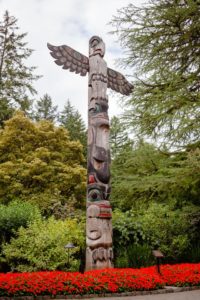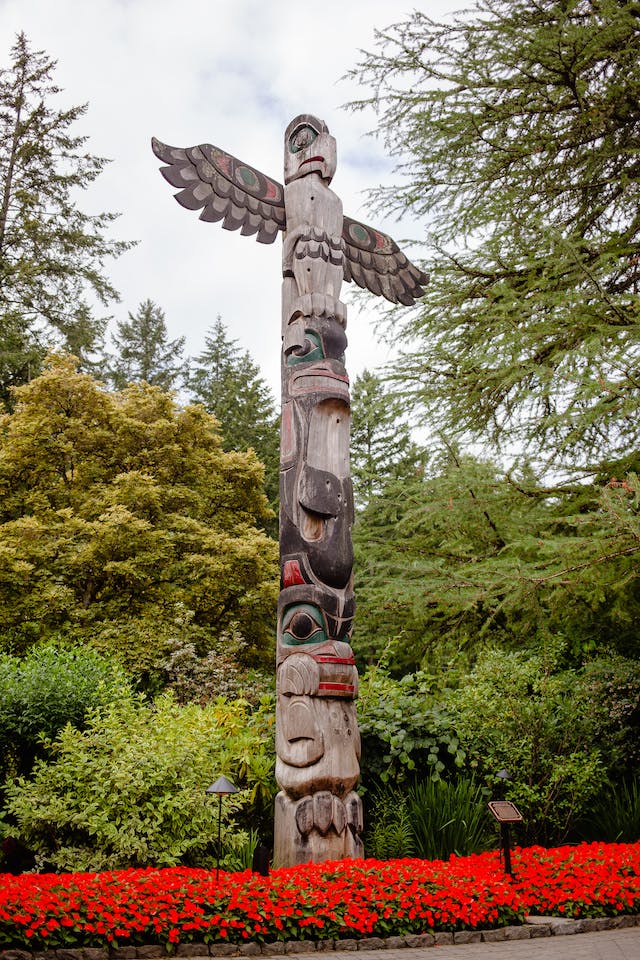
What are totem poles for? They have many different uses, but a common use it to show the lineage of a family or notable events that have happened and need to be remembered. They are a kind of written record for the tribe.
When we watch Hollywood movies, every Native American tribe has a totem pole, but not all Native Americans use totem poles. They are typically found in western Canada and the northwestern United States. The English word “totem” comes from the Algonquian word “odoodem”, which means “kinship group” or “clan”. It is interesting that the English word comes from Algonquian because the groups of people that spoke this language lived in the east of north America and the people that made totem poles lived in the west of north America. I am speculating here, but perhaps that is because the English speakers that used the word came into the Americas from the east and had contact with those peoples first. Maybe they picked up parts of the language and when the reached the west, they used those pieces of language to name things. The people in the east do carve symbols for their families and clans, so maybe the English speakers took that word and assumed that they were looking at the same things when they reached the west.
Nobody knows when the practice of using totems and totem poles began. They are usually carved from the giant cedar tree or the western red cedar. These trees are tall, straight, and very resistant to rot. However, once their bark has been removed, they slowly decay. The climate along the western coast of America up through Canada is very wet and rainy, so totem poles wouldn’t last longer than a hundred years. Early settlers reported seeing totem poles, so, logically, the tradition comes from at least 100 years before then. The number of totem poles also increased after Europeans arrived in north America. There were several reasons for this. Firstly, iron tools and iron smelting skills were introduced. The Native Americans that lived in north America used stone tools and copper tools to carve wood and they did not start smelting iron until the Europeans arrived. Iron tools make carving wood a lot easier, so the amount of totem poles increased. Secondly, the fur trade with the Europeans brought in more money. More wealth meant that more families could commission totem poles. They possibly also increased because small pox and other diseases brought in by the Europeans decimated the Native Americans. It possibly became more important for them to have records of their clans.
The early explorers and the people that came up with the English word totem, possibly misunderstood the purpose of the totem poles. In English, a totem is “an object or animal that is believed by a particular society to have spiritual significance and that is adopted by it as an emblem.” The totems on a totem pole do not have any religious significance. So, what do the totem poles represent? There are several kinds of totem pole. Poles that show stories, legends, commemorate ancestors, celebrate living people, remember important events, ridicule someone, hold a dead ancestor’s remains, show a clan lineage or status, remember debts, battles, or crimes. The poles also vary from group to group. An animal that might mean one thing to one group could mean something completely different to another group.
Totem poles are displayed in six main places. They can the post of a house. The main front strut of the house that supports the roof beam is often a totem pole. It is connected to the family that lives in the house and is similar to a crest of arms in Europe. It might have a record of the people who have lived in the house or the family history. There are interior house posts. These are similar to the house post, but they are smaller and hold up the roof from inside. Then there are mortuary poles that commemorate someone’s death. Ashes from the body are usually placed inside. There are memorial poles which are built to remember someone. The totem pole that is usually found in the center of the village is the chief’s totem pole. There are welcome poles that are placed at the edge of the village and welcome people in. And, finally, there are ridicule or shame poles, which are built to remember a shameful act. There is a famous shame pole that was built in 1989 to remember the ExxonMobil disaster when the Exxon Valdez dumped 42 million liters of oil into the sea near Alaska. The company were fined $5 million, which they haven’t paid. The shame pole was built to remember the unpaid debt and the crime.
By the end of the 19th century, totem pole making had pretty much stopped. Laws were passed against Indigenous people’s religions, which, mistakenly, included totem poles. Missionaries also persuaded people to stop making them and burn the ones that already existed. It wasn’t until the 1960s and the pro-Indigenous people laws that were passed then that totem pole carving began again. And this is what I learned today.
Photo by Wendy Wei: https://www.pexels.com/photo/trees-near-a-totem-pole-13244365/
Sources
https://en.wikipedia.org/wiki/Totem_pole
https://en.wikipedia.org/wiki/Algonquian_languages
https://www.thecanadianencyclopedia.ca/en/article/totem-pole
https://www.answers.com/Q/Where_do_totem_poles_come_from
https://www.quora.com/Why-did-Native-Americans-build-totem-poles
https://www.smithsonianmag.com/travel/on-the-totem-trail-44529691/

